When the first fine days of June beckon, runners and cyclists head outside with the enthusiasm of kids escaping school for three months of summer break. They welcome the opportunity to bask in the sunlight, fresh air and scenery. Most gym-goers relish the idea of taking their workouts outside, too. But how? Even if you do jog or bike, the options for comprehensive, gymlike workouts are limited. After all, it’s not like you can easily drag free weights, machines and most other equipment outdoors.
But there is an excellent piece of equipment you can take with you whenever you’re outside: your body. By using your body weight — along with convenient outdoor props such as trees, curbs and benches — you can approximate or complement your usual strength-training routine in ways that make your gym workouts even better.
The secret lies in knowing how to redistribute your weight and apply leverage to increase or reduce the intensity, explains strength-training expert Pavel Tsatsouline, author of The Naked Warrior. “For instance, when you do a basic pushup, you lift about half your body weight,” he says. “But if you elevate your feet on a park bench, you can increase the load to 70 percent of your body weight.”
Tsatsouline asserts that by just using two basic body-weight exercises — the pushup and the squat — you can get enough variation to build endurance, explosive power and maximum strength. For example, you can use classic high-repetition pushups (15 to 50 reps on your toes or knees) to develop muscular endurance. For explosive power, try blasting off the ground high enough to clap your hands between each repetition. For maximum strength, Tsatsouline recommends attempting some one-arm pushups or propping your feet up on a park bench.
To work the lower body, use high-repetition body-weight squats for muscular endurance and one-legged squats for lower-body strength. Try vertical jumps and broad jumps to develop explosive power.
With a little creativity, you can add all kinds of combinations to your outdoor routine. And finding natural props to facilitate your training is generally a snap. Turn the page for a simple workout plan that will get you started. As with any exercise program, consult your doctor before attempting unfamiliar exercises, particularly if you have an injury, chronic weakness or illness. Begin slowly and work your way up to the recommended reps.
Oak-Tree Raises
A tree is a great place to perform heel raises — good for conditioning the calves and stretching the Achilles’ tendon.

- Stand about 3 feet from a tree, extend your arms and lean forward, placing your palms on the trunk while keeping your heels on the ground. Keep your spine, legs and arms as straight as you can.
- Slowly rise up on the balls of your feet, lifting yourself as high as possible.
- Hold for two seconds and then lower slowly.
- To make it harder, wrap one foot around the opposite calf (shown) and perform the exercise one leg at a time.
- Repeat 15 to 20 times and do three sets.
Oak-Tree Squats
Use a large tree for support while doing this “phantom chair” exercise, which provides a great workout for your hip extensors (back of the legs and butt muscles) and knee extensors (front of the thigh).
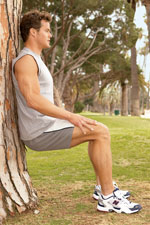
- Lean back against the tree, keeping your knees bent and feet shoulder-width apart, toes pointed out slightly.
- Slowly bend your knees until the tops of your thighs are parallel to the ground.
- Keep the base of your back pressed firmly against the trunk.
- Hold this position until your muscles tire and then slowly straighten your legs and rest for one minute.
- Repeat three times.
Trunk-Training Burpees
This exercise works your entire midsection.
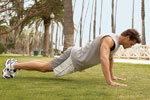
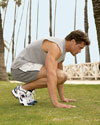
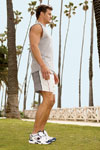
- Begin in the pushup position. Keeping your hands stationary and on the ground, jump forward so that your knees end up under your elbows and you are in a tucked position, knees bent, heels under your buttocks and toes right behind your hands.
- Stand and then immediately reverse the movement so you end up in the pushup position again.
- Repeat 10 to 20 times and do three sets.
- Need more of a challenge? Add a pushup between each rep.
- See “How to Do a Burpee” to perfect your burpee technique.
Fencepost Rows
This exercise works the back much like the seated row at the gym.

- Find a sturdy fencepost or small-diameter tree trunk and wrap a towel around it at waist height. Grab an end of the towel in each hand and stand back about a foot.
- Squat slightly, carefully hanging backward on the towel and keeping your arms straight.
- Slowly pull yourself toward the tree, then return to the start position.
- You can change the difficulty by adjusting your position — squat lower, or move your feet closer or farther from the tree. The steeper the angle, the more difficult the exercise. You can also grab both ends of the towel with one hand.
- Try five to 10 sets of five reps each, or three sets of 10.
Tense Pushups
Tsatsouline stresses that maximum strength comes from maximum tension. This variation of the classic pushup is a good way to teach yourself how to load tension into your muscles before an exertion.


- Choose an even spot on the ground and do five traditional pushups (on your toes or knees), but relax completely between reps. You’ll notice that you have to tense your muscles just before pushing yourself back up.
- Now do another five “full-relaxation” pushups, but this time, maximally tense your entire body before pushing up. You’ll notice you have much more strength.
- If this is easy, begin working on your single-arm pushup by placing your right hand on the ground along the centerline of your body with your left hand behind your back. Separate your legs apart for stability and press off the ground.
- See “Pavel Tsatsouline’s Guide to Pushups, Sit-Ups, and Squats” for more.
A Backyard Calorie Burning Workout
Getting your aerobic exercise outside is easy if you happen to enjoy cycling or running. But if you don’t, here are three rebounding exercises that can burn a barbecue’s worth of calories:
Sprinters’ Start Jumps
- Begin in a racer’s starting position with your hands on the ground under your shoulders, arms straight.
- Bend your right leg to the front of your body, under your chest. Extend your left leg back behind you, knee bent slightly and supported on the ball of your foot.
- Then jump to alternate leg positions, bringing the left leg forward and the right leg back.
- Rest your weight on your arms as you jump, alternating legs in a half-second cadence.
- Repeat 20 to 30 times with each leg and complete two sets.
Squat Jumps
- Stand with your legs shoulder-width apart, toes turned outward. Place your fingers lightly behind your head.
- Keeping your back erect, bend your knees and hips, lowering into the squat position.
- When the tops of your thighs are parallel with the ground, extend your legs powerfully and leap as high as you can.
- Flex your knees when you land to cushion the impact, making sure they don’t dive inward. Check your form and repeat five to 10 times in a one-second cadence.
- Rest 30 seconds between each round and complete two sets.
Split Jumps
- Standing with legs hip-width apart, step forward with your right foot, left leg behind you, knees slightly bent, spine erect. Lower your hips so that your left knee drops toward the ground.
- Your left leg is supported on the ball of your foot while your right knee bends until your thigh is parallel to the ground.
- From this position, jump explosively, switching legs in flight so that you land in a lunge position with your left (or opposite) leg forward.
- Then alternate legs in a half-second cadence, repeating eight to 12 times to complete two sets.
Fresh Tips
Follow these suggestions for a safe, comfortable open-air workout:
- Pack plenty of water. In the heat, you’ll need about 8 ounces for every 15 to 20 minutes of exercise. Keep about 16 ounces of water in an athletic water bottle for immediate use and another 24 to 48 ounces in a thermos to keep it cool. You can also opt for a water carrier that fits like a backpack.
- Choose an area with a bathroom nearby.
- Use a sports watch with a stopwatch function to keep track of your exercise intervals and water consumption.
- Wear a wristband or bring a towel to mop up sweat.
- Dump the baseball cap. Most are made from heavy cotton that keeps heat from escaping and absorbs sweat like a sponge.For better sun protection, go for a runner’s cap made of breathable material like CoolMax with mesh sides for better ventilation. Keep the colors light: white, yellow or blue.
- Always wear sunglasses to protect your eyes. You may want to invest in a wraparound style to keep the glare out of your front view and peripheral vision. Look for brands with rubber ends, since they prevent slippage when you sweat.
- Apply sunscreen on your face and any exposed skin, such as arms and legs, if you are going to be outdoors for more than 15 minutes. Getting a little sunshine will probably do you good, but you don’t want to risk a burn.
- Pin your house key and car keys in your pocket so you won’t lose them.
- Stuff a washcloth or rag into a backpack so you can wipe your face and sunglasses as needed.
Bonus! More Outdoor Exercises
- Park-Bench Dips: Use the seat of a park bench to exercise your triceps and latissimus dorsi (mid and lower back). Facing away from the bench, bend your knees and hold the edge of the bench seat with arms shoulder-width apart and fully extended. Keeping your feet directly below your knees will make the exercise relatively easy; to make it harder, stretch your legs out in front of you. Bend your elbows and slowly lower your buttocks. Descend as low as you can without touching the ground, and then extend your arms to raise your torso back to the starting position. Perform three sets of 10 to 15 repetitions each.
- Airborne Lunge: An easy-looking but tough exercise that helps pave the way toward one-legged squats, this is one of the most elite body-weight exercises. Begin by standing with your feet shoulder-width apart. Bend your left leg and raise your heel toward your buttocks. Squat with the right leg until your knee (but not your foot) touches the ground, then go back up. It helps to reach forward and bend over slightly as if reaching for the ground. Make sure your right heel stays planted. Complete two reps and switch legs. Try to do three to five sets. Use caution if you have bad knees. You can also use a bench for balance.
This article originally appeared as “Take It Outside” in the June 2009 issue of Experience Life.

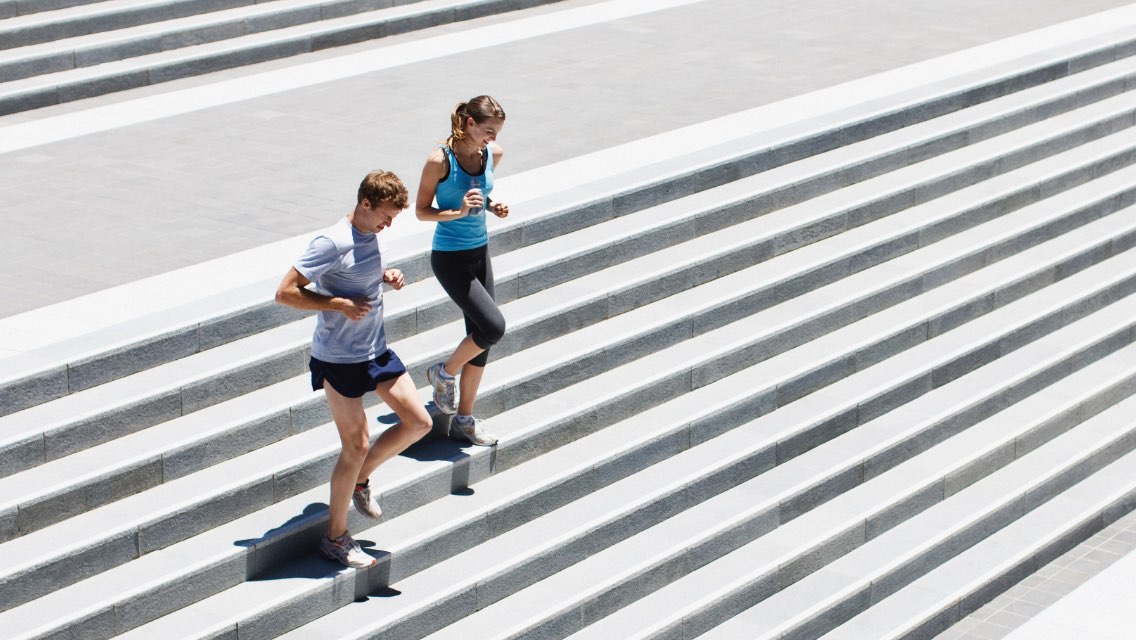
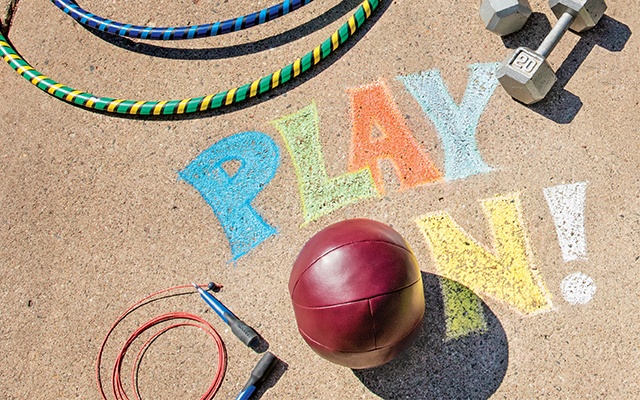
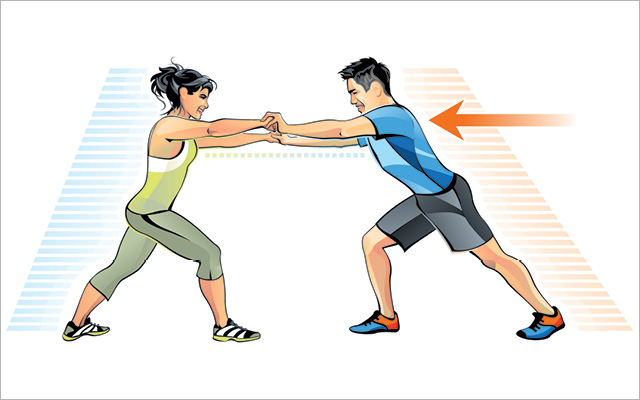
This Post Has 0 Comments